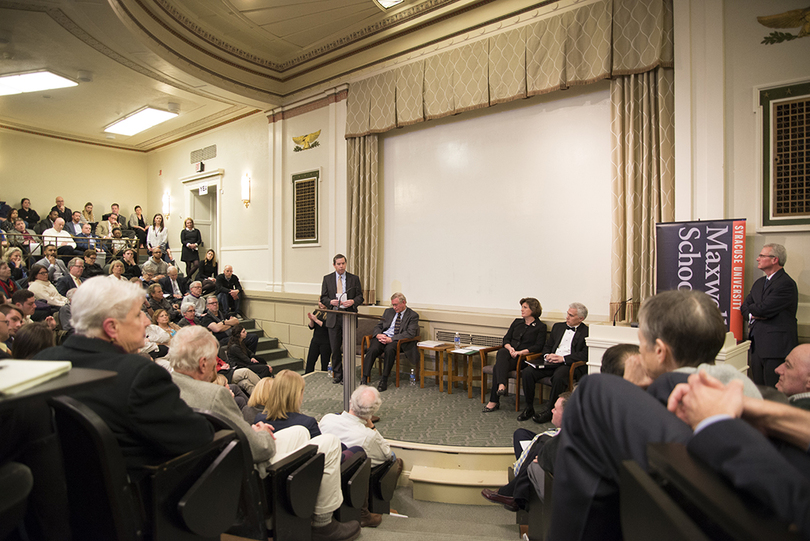Central New York leaders exchange fiery remarks in merger debate

Those who debated on Wednesday included James Walsh, a former member of Congress; William Byrne, Chairman of the Board of Byrne Dairy; Stephanie Miner, Syracuse mayor; and Robert Antonacci, Onondaga County comptroller. Colin Davy | Asst. Photo Editor
Central New York leaders collided head-to-head Wednesday over a proposal to merge the city of Syracuse and Onondaga County governments during a 90-minute impassioned debate driven mostly by policy issues.
In a packed Maxwell Auditorium at Syracuse University, James Walsh, a former congressman, and William Byrne, chairman of the board of Byrne Dairy, engaged in debate with Syracuse Mayor Stephanie Miner and Onondaga County Comptroller Robert Antonacci. Walsh and Byrne support the merger whereas Miner and expressed opposition to the proposal.
Moderated by Grant Reeher, political science professor at the Maxwell School of Citizenship and Public Affairs, the debate began with relatively toned-down statements from the individuals in both camps to advance their argument. As the debate went on, however, their exchanges heated to the point that Byrne’s face grew red in a visible sign of agitation.
Consensus, a citizen group composed of legislators and community leaders including Walsh, recommended the two governments to merge in its report released in February. Underscoring the city’s decades-long stagnation and dire fiscal state, the report identified areas of savings in 16 categories — including law enforcement, water services and street and highway maintenance — and endorsed unification of these services along with creating a new metropolitan government.

In his introductory remark, Byrne painted a grim picture that Syracuse faces: sluggish economic development, fleeing population, high tax and rising level of poverty. Referring to a recent Brookings Institution report that ranked Syracuse at the bottom in economic development among cities, Byrne pinned the blame on local government and advocated for government efficiency by reducing duplicate services that are offered by both the city or town and the county.
“The statistics show that we are a community in trouble both in Syracuse and Onondaga County,” Byrne said. “ … It’s time to take action.”
Walsh presented a message captured in one sentence: “we can do better.” Walsh criticized bloated level of elected representatives in the community by citing recent elections in local villages and towns. Walsh said winners only gained votes in teens, questioning whether voters in those areas really know the elections took place.
“When it comes to representation, we can do a lot better. We propose a model we believe will do better,” Walsh said. “ … If we are starting in a clean sheet of paper nobody would draw lines that are drawn today.”
The group has proposed the city and county governments be combined into one legislative body with 33 legislators. The legislative body would be composed of 29 districts and four at-large representatives, with each representative carrying one vote. Nine out of the 29 districts would be drawn in combined, city-suburb “hybrid” districts.
In contrast, Miner highlighted that the city is making progress in the economy and its progressive model defending human rights — including controversial “sanctuary cities” and its history of raising minimum wage ahead of other cities in the Unites States — while criticizing the county leaders for keeping quiet. The city of Syracuse is the engine that can power economic growth in the region, Miner added.
“Syracuse is the health care center, recreational center, culture center and economic center of central New York,” Miner said. “ … The vibrancy that my opponents don’t like to actually point out: downtown has had more people living there than ever before. They’ve had more growth than ever before.”
Miner did not hesitate to demonstrate her disdain for the merger, saying that the city would be flummoxed with debts and obligations and further disenfranchised minority groups. This argument was a sticking point through the debate, as Walsh and Byrne claimed it was false but Miner did not recant her talking point.
“By saddling the city of Syracuse with $1 billion debt and calling us ‘a debt district’ we make them less competitive, residents will move out. … Put succinctly, replacing a vibrant city with a debt district will extinguish any idea of a vibrant county or a vibrant region,” Miner said.
The Consensus report claims the city-county consolidation could yield between $8.7 and $22.9 million in savings and the unification of services would save between $7.9 and $ 9.9 million a year.
Antonacci, who appeared to be skeptical of the report’s figure, called for the savings identified in the report to be vetted and audited before heading to go ballot.
“We have been inclined to believe whatever a snake oil salesman offers without a proof of evidence,” he said.
The Consensus report proposed a ballot initiative on the merger to take place this year.
But Linda Ervin, floor leader and representative for the Onondaga County Legislature’s 17th district, ruled out the feasibility of the legislature to approve a referendum this year — dashing the hope for a referendum despite Onondaga County Executive Joanie Mahoney, who attended the debate, recently calling for the referendum to take place.
Antonacci and Miner, both debating against the merger, disagreed over whether the referendum should happen. The comptroller echoed Mahoney in calling for the referendum to take place, while Miner questioned the legitimacy of holding a referendum while voters are unsure of what they are voting for.




